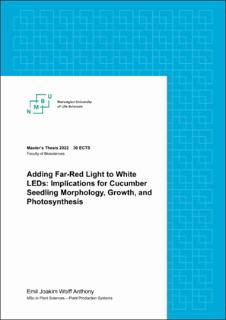| dc.contributor.advisor | Torre, Sissel | |
| dc.contributor.advisor | Solhaug, Knut Asbjørn | |
| dc.contributor.author | Anthony, Emil Joakim Wolff | |
| dc.date.accessioned | 2022-09-21T12:52:35Z | |
| dc.date.available | 2022-09-21T12:52:35Z | |
| dc.date.issued | 2022 | |
| dc.identifier.uri | https://hdl.handle.net/11250/3020247 | |
| dc.description.abstract | Far-red (FR) light (700–800 nm) affects photosynthetic efficiency and regulates shade responses, which influences plant morphology and growth. However, plant responses to FR vary widely between environmental conditions, species, and even genotypes. Here, we investigated the responses of cucumber (Cucumis sativus L. ’Hi Light’ and ’Imea’) seedlings to the addition of FR (peak = 732 nm) under a common background of white light by using light-emitting diodes (LEDs). In three controlled environment experiments, seedlings were subjected for ten days to either a white light control or one of three FR treatments: high intensity continuous FR in the photoperiod (110 μmol m−2 s−1 of FR), low intensity continuous FR (50 μmol m−2 s−1 of FR), or end-of-day FR (EOD-FR; 1.5 h of 110 μmol m−2 s−1 of FR) added to a common background of white light (photosynthetic photon flux density of 240 μmol m−2 s−1). Plant morphology, growth components, and leaf photosynthetic light responses were analysed and compared with plants exposed to corresponding white light controls.
Adding FR commonly resulted in increased shoot length, leaf expansion, and improved growth when compared to white light treatments. Relative growth rates (RGRs) increased by 8–18% as a result of large increases in net assimilation rates (NARs) and in spite of decreased leaf area ratios (LARs). Decreased LARs were largely caused by decreased leaf mass ratios (LMRs) due to greater dry mass partitioning to stem and petioles at the expense of leaves. Under EOD-FR, the negative influence of LMR on LAR was partly mitigated as specific leaf areas (SLAs), the other component of LAR, slightly increased. Continuous FR commonly resulted in increased leaf photosynthetic capacity but no changes were observed following EOD-FR. Moreover, FR decreased total chlorophylls and carotenoids concentrations. Despite differences in morphological and physiological traits, like leaf area and photosynthetic capacity, the cultivars ’Hi Light’ and ’Imea’ responded similarly to supplemental FR in terms of relative changes in plant morphology and growth components. We conclude that supplemental FR, either continuously in the photoperiod or as EOD-FR, under sole-source lighting can improve cucumber plant growth through complex plant morphological and physiological changes. | en_US |
| dc.language.iso | eng | en_US |
| dc.publisher | Norwegian University of Life Sciences, Ås | en_US |
| dc.rights | Attribution-NonCommercial-NoDerivatives 4.0 Internasjonal | * |
| dc.rights.uri | http://creativecommons.org/licenses/by-nc-nd/4.0/deed.no | * |
| dc.subject | Cucumber | en_US |
| dc.subject | Greenhouse | en_US |
| dc.subject | Photosynthesis | en_US |
| dc.subject | Morphology | en_US |
| dc.subject | Growth analysis | en_US |
| dc.subject | Far-red | en_US |
| dc.subject | Light-emitting diodes | en_US |
| dc.subject | LEDs | en_US |
| dc.subject | Controlled environment agriculture | en_US |
| dc.subject | Supplemental lighting | en_US |
| dc.subject | End-of-day | en_US |
| dc.title | Adding far-red light to white LEDs : implications for cucumber seedling morphology, growth, and photosynthesis | en_US |
| dc.type | Master thesis | en_US |
| dc.subject.nsi | VDP::Mathematics and natural science: 400::Zoology and botany: 480::Plant physiology: 492 | en_US |
| dc.subject.nsi | VDP::Agriculture and fishery disciplines: 900::Agriculture disciplines: 910::Plant breeding, horticulture, plant protection, plant pathology: 911 | en_US |
| dc.description.localcode | M-PV | en_US |

